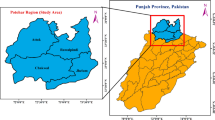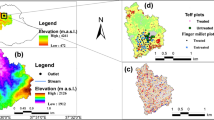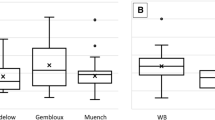Abstract
In this study, we tried to address the applicability of using dynamic remotely sensed data into a static crop model to capture the yield spatiotemporal variability at the field scale. Taking the example of the crop environment resource synthesis for wheat (CERES-wheat), the model was calibrated, improved, and validated using three years of winter wheat field measurement data (growing seasons of 2017–2019). We assimilated the Landsat-based leaf area index (LAI) into the model using the particle filter approach. Four vegetation indices, including NDVI, SAVI, EVI, and EVI-2, were evaluated to identify winter wheat LAI’s best estimator. A linear regression of Landsat-EVI-2 was found to be the most accurate representation of LAI (LAI = 10.08 × EVI-2 − 0.53) with R2 = 0.87, and mean bias error = − 2.04. The higher LAI accuracy from EVI-2 was attributed to the soil and canopy background noise reduction and accounting for certain atmospheric conditions. Assimilating the LAI based on Landsat-EVI-2 into the CERES model improved the model’s overall performance, particularly for grain yield and biomass simulations. The default model predicted LAImax, grain yield, and biomass at 5.1 cm2 cm−2, 8.3 Mg ha−1, and 14.9 Mg ha−1 with RMSE of 1.44, 0.91 Mg ha−1, and 1.2 Mg ha−1, respectively, while the modified model (using the Landsat-EVI-2 data) predicated these values at 6.6 cm2 cm−2, 9.9 Mg ha−1, and 16.6 Mg ha−1 with RMSE of 0.81, 0.54 Mg ha−1, and 0.62 Mg ha−1, respectively.







Similar content being viewed by others
References
Ahmadi, K., et al. (2018). Agricultural Statistics in 2017. Center for Information and Communication Technology, Department of Planning and Economic, Ministry of Agriculture (Vol 147).
Allen, R. G., et al. (1998). Crop evapotranspiration-guidelines for computing crop water requirements-FAO Irrigation and drainage paper 56. Fao, Rome, 1998. 300(9): p. D05109
Andarzian, B., et al. (2015). Determining optimum sowing date of wheat using CSM-CERES-wheat model. Journal of the Saudi society of agricultural sciences, 14(2), 189–199.
Attia, A., et al. (2016). Application of DSSAT-CERES-wheat model to simulate winter wheat response to irrigation management in the Texas High Plains. Agricultural Water Management, 165, 50–60.
Bannayan, M., Crout, N., & Hoogenboom, G. (2003). Application of the CERES-wheat model for within-season prediction of winter wheat yield in the United Kingdom. Agronomy Journal, 95(1), 114–125.
Bannayan, M., & Hoogenboom, G. (2009). Using pattern recognition for estimating cultivar coefficients of a crop simulation model. Field Crops Research, 111(3), 290–302.
Bartzanas, T., et al. (2013). Computational fluid dynamics applications to improve crop production systems. Computers and Electronics in Agriculture, 93, 151–167.
Basso, B., Cammarano, D., & Carfagna, E. (2013). Review of crop yield forecasting methods and early warning systems. In Proceedings of the first meeting of the scientific advisory committee of the global strategy to improve agricultural and rural statistics. FAO Headquarters, Rome, Italy.
Bezuidenhout, C. N. (2000). A model review and proposed mechanistic tiller model for the CANEGRO sugarcane crop model. M. Tech, Doctoral dissertation, Thesis-Technikon Natal, Durban, 78p.
Boote, K., et al. (1998). The CROPGRO model for grain legumes. In Understanding options for agricultural production, 1998 (pp. 99-128). Springer.
Cai, Y., et al. (2019). Integrating satellite and climate data to predict wheat yield in Australia using machine learning approaches. Agricultural and Forest Meteorology, 274, 144–159.
Canty, M. J. (2019). Image analysis, classification and change detection in remote sensing: With algorithms for Python. Boca Raton: CRC Press.
Chenu, K., et al. (2017). Contribution of crop models to adaptation in wheat. Trends in Plant Science, 22(6), 472–490.
Choudhury, B., Idso, S., & Reginato, R. (1987). Analysis of an empirical model for soil heat flux under a growing wheat crop for estimating evaporation by an infrared-temperature based energy balance equation. Agricultural and Forest Meteorology, 39(4), 283–297.
Dente, L., et al. (2008). Assimilation of leaf area index derived from ASAR and MERIS data into CERES-wheat model to map wheat yield. Remote Sensing of Environment, 112(4), 1395–1407.
Dettori, M., et al. (2011). Using CERES-wheat to simulate durum wheat production and phenology in Southern Sardinia, Italy. Field Crops Research, 120(1), 179–188.
Duan, T., et al. (2017). Dynamic monitoring of NDVI in wheat agronomy and breeding trials using an unmanned aerial vehicle. Field Crops Research, 210, 71–80.
Estes, L., et al. (2013). Comparing mechanistic and empirical model projections of crop suitability and productivity: Implications for ecological forecasting. Global Ecology and Biogeography, 22(8), 1007–1018.
Faostat, F. (2017). http://www.fao.org/faostat/en/#data. QC. Accessed January 2018.
Folberth, C., et al. (2019). Spatio-temporal downscaling of gridded crop model yield estimates based on machine learning. Agricultural and Forest Meteorology, 264, 1–15.
Gustafson, D., et al. (2005). An empirical model for pollen-mediated gene flow in wheat. Crop Science, 45(4), 1286–1294.
Herrmann, I., et al. (2011). LAI assessment of wheat and potato crops by VENμS and Sentinel-2 bands. Remote Sensing of Environment, 115(8), 2141–2151.
Hlavinka, P., et al. (2010). The performance of CERES-Barley and CERES-wheat under various soil conditions and tillage practices in Central Europe. Die Bodenkultur, 61, 5–17.
Hosseini, M., et al. (2015). Estimation of Leaf Area Index (LAI) in corn and soybeans using multi-polarization C-and L-band radar data. Remote Sensing of Environment, 170, 77–89.
Houborg, R., & McCabe, M. F. (2018). Daily retrieval of NDVI and LAI at 3 m resolution via the fusion of CubeSat, Landsat, and MODIS data. Remote Sensing, 10(6), 890.
Huang, J., et al. (2015). Improving winter wheat yield estimation by assimilation of the leaf area index from Landsat TM and MODIS data into the WOFOST model. Agricultural and Forest Meteorology, 204, 106–121.
Huete, A. (1988). A soil-adjusted vegetation index (SAVI). Remote Sensing of Environment, 25, 295–309.
Huete, A., Justice, C., & Liu, H. (1994). Development of vegetation and soil indices for MODIS-EOS. Remote Sensing of Environment, 49(3), 224–234.
Hussain, J., et al. (2018). Performance of four crop model for simulations of wheat phenology, leaf growth, biomass and yield across planting dates. PloS One, 13(6).
Iglesias, A. (2006). Use of DSSAT models for climate change impact assessment: Calibration and validation of CERES-Wheat and CERES-Maize in Spain. In Climate variability, modelling tools and agricultural decisionmaking. Proceedings of CGE Hands-on Training Workshop on V&A Assessment of the Asia and the Pacific Region. New York, NY: Nova Science Publishers.
Jafari, M., et al. (2021). Estimation of evapotranspiration and crop coefficient of drip-irrigated orange trees under a semi-arid climate. Agricultural Water Management, 248, 106769.
Jamshidi, S., et al. (2019a). Application of a simple Landsat-MODIS fusion model to estimate evapotranspiration over a heterogeneous sparse vegetation region. Remote Sensing, 11(7), 741.
Jamshidi, S., et al. (2019b). Evaluation of evapotranspiration over a semiarid region using multiresolution data sources. Journal of Hydrometeorology, 20(5), 947–964.
Jamshidi, S., et al. (2020). Evapotranspiration, crop coefficients, and physiological responses of citrus trees in semi-arid climatic conditions. Agricultural Water Management, 227, 105838.
Jamshidi, S., Zand-Parsa, S., & Niyogi, D. (2021a). Assessing crop water stress index of citrus using in-situ measurements, Landsat, and Sentinel-2 Data. International Journal of Remote Sensing, 42(5), 1893–1916.
Jamshidi, S., Zand-Parsa, S., & Niyogi, D. (2021b). Physiological responses of orange trees subject to regulated deficit irrigation and partial root drying. Irrigation Science, 39, 1–15.
Jiang, Z., et al. (2008). Development of a two-band enhanced vegetation index without a blue band. Remote sensing of Environment, 112(10), 3833–3845.
Jin, X., et al. (2018). A review of data assimilation of remote sensing and crop models. European Journal of Agronomy, 92, 141–152.
Johnen, T., Boettcher, U., & Kage, H. (2012). A variable thermal time of the double ridge to flag leaf emergence phase improves the predictive quality of a CERES-wheat type phenology model. Computers and Electronics in Agriculture, 89, 62–69.
Kuwata, K., & Shibasaki, R. (2015) Estimating crop yields with deep learning and remotely sensed data. In 2015 IEEE International Geoscience and Remote Sensing Symposium (IGARSS). 2015. IEEE.
Li, H., et al. (2017a). Comparative analysis of GF-1, HJ-1, and Landsat-8 data for estimating the leaf area index of winter wheat. Journal of Integrative Agriculture, 16(2), 266–285.
Li, H., et al. (2017b). Improving winter wheat yield estimation from the CERES-wheat model to assimilate leaf area index with different assimilation methods and spatio-temporal scales. Remote Sensing, 9(3), 190.
Liakos, K. G., et al. (2018). Machine learning in agriculture: A review. Sensors, 18(8), 2674.
Mehrabi, F., & Sepaskhah, A. R. (2019). Winter wheat yield and DSSAT model evaluation in a diverse semi-arid climate and agronomic practices. International Journal of Plant Production, 14, 1–23.
Moghimi, M. M., Sepaskhah, A., & Kamgar-Haghighi, A. A. (2015). Irrigation scheduling and winter wheat grain yield estimation under precipitation uncertainty—A case study in Badjgah area (Fars Province, Iran). Iran Agricultural Research, 34(1), 21–30.
Monteith, J. L. (1996). The quest for balance in crop modeling. Agronomy Journal, 88(5), 695–697.
Niyogi, D., et al. (2020). Evapotranspiration climatology of Indiana using in situ and remotely sensed products. Journal of Applied Meteorology and Climatology, 59(12), 2093–2111.
Noshadi, M., & Jamshidi, S. (2014). Modification of water movement equations in the PRZM3 for simulating pesticides in soil profile. Agricultural Water Management, 143, 38–47.
Overman, A., Scholtz, R., III., & Martin, F. (2003). In defense of the extended logistic model of crop production. Communications in Soil Science and Plant Analysis, 34(5–6), 851–864.
Pontailler, J.-Y., Hymus, G. J., & Drake, B. G. (2003). Estimation of leaf area index using ground-based remote sensed NDVI measurements: Validation and comparison with two indirect techniques. Canadian Journal of Remote Sensing, 29(3), 381–387.
Priestley, C. H. B., & Taylor, R. (1972). On the assessment of surface heat flux and evaporation using large-scale parameters. Monthly Weather Review, 100(2), 81–92.
Rathore, V. S., et al. (2017). Yield, water and nitrogen use efficiencies of sprinkler irrigated wheat grown under different irrigation and nitrogen levels in an arid region. Agricultural Water Management, 187, 232–245.
Ritchie, J. (1985). Description and performance of CERES wheat: A user-oriented wheat yield model. ARS wheat yield project, 1985, pp. 159–175.
Rouse, J., et al. (1974). Monitoring vegetation systems in the Great Plains with ERTS. NASA special publication, 351, 309.
Sepaskhah, A. R., Fahandezh-Saadi, S., & Zand-Parsa, S. (2011). Logistic model application for prediction of maize yield under water and nitrogen management. Agricultural Water Management, 99(1), 51–57.
Shewry, P. R. (2009). Wheat. Journal of Experimental Botany, 60(6), 1537–1553.
Singh, A. K., Tripathy, R., & Chopra, U. K. (2008). Evaluation of CERES-wheat and CropSyst models for water–nitrogen interactions in wheat crop. Agricultural water management, 95(7), 776–786.
Tao, F., et al. (2018). Contribution of crop model structure, parameters and climate projections to uncertainty in climate change impact assessments. Global Change Biology, 24(3), 1291–1307.
Timsina, J., et al. (2008). Evaluation of options for increasing yield and water productivity of wheat in Punjab, India using the DSSAT-CSM-CERES-wheat model. Agricultural Water Management, 95(9), 1099–1110.
Timsina, J., & Humphreys, E. (2006). Performance of CERES-Rice and CERES-wheat models in rice–wheat systems: A review. Agricultural Systems, 90(1–3), 5–31.
Tsuji, G. Y., Uehara, G., & Balas, S. (1994). DSSAT version 3.
Wang, L., et al. (2013). LAI retrieval using PROSAIL model and optimal angle combination of multi-angular data in wheat. IEEE Journal of Selected Topics in Applied Earth Observations and Remote Sensing, 6(3), 1730–1736.
De Wit, A. D., & Van Diepen, C. (2007). Crop model data assimilation with the Ensemble Kalman filter for improving regional crop yield forecasts. Agricultural and Forest Meteorology, 146(1–2), 38–56.
Wu, B., et al. (2015). Global crop monitoring: A satellite-based hierarchical approach. Remote Sensing, 7(4), 3907–3933.
Xiong, W., et al. (2008). Evaluation of CERES-wheat simulation of wheat production in China. Agronomy Journal, 100(6), 1720–1728.
Yang, A., et al. (2015). Cross-calibration of GF-1/WFV over a desert site using Landsat-8/OLI imagery and ZY-3/TLC data. Remote Sensing, 7(8), 10763–10787.
Yi, Y., et al. (2008). Evaluation of MODIS surface reflectance products for wheat leaf area index (LAI) retrieval. ISPRS Journal of Photogrammetry and Remote Sensing, 63(6), 661–677.
Zhao, F., et al. (2011). Measuring effective leaf area index, foliage profile, and stand height in New England forest stands using a full-waveform ground-based lidar. Remote Sensing of Environment, 115(11), 2954–2964.
Zheng, G., & Moskal, L. M. (2009). Retrieving leaf area index (LAI) using remote sensing: Theories, methods and sensors. Sensors, 9(4), 2719–2745.
Author information
Authors and Affiliations
Contributions
Mohammad Jafari performed conceptualization and methodology; Ali, Keshavarz contributed to software, validation and analysis, and investigation; both authors have contributed to the writing—original draft preparation; and editing, supervision, and project administration were performed by Mohammad Jafari.
Corresponding author
Ethics declarations
Conflict of interest
The authors of the study including “Mohammad Jafari and Ali Keshavarz” certify that they have no affiliations with or involvement in any organization or entity with any financial or non-financial interest in the subject matter or materials discussed in this manuscript.
Additional information
Publisher's Note
Springer Nature remains neutral with regard to jurisdictional claims in published maps and institutional affiliations.
About this article
Cite this article
Jafari, M., Keshavarz, A. Improving CERES-Wheat Yield Forecasts by Assimilating Dynamic Landsat-Based Leaf Area Index: A Case Study in Iran. J Indian Soc Remote Sens 50, 285–298 (2022). https://doi.org/10.1007/s12524-021-01359-w
Received:
Accepted:
Published:
Issue Date:
DOI: https://doi.org/10.1007/s12524-021-01359-w




